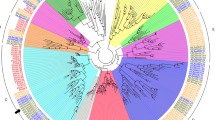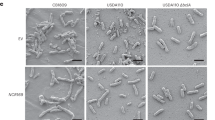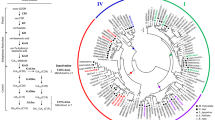Abstract
Two leghaemoglobin genes from the diploid, autogamousMedicago truncatula (Mtlb1 andMtlb2) have been cloned and their nucleotide sequences determined. The deduced amino acid sequences encoded by these two genes differ significantly (18%), confirming that they belong to different sub-groups ofMedicago leghaemoglobin genes [2]. RNAse protection experiments have been used to show that both genes are transcriptionally active, and are expressed specifically in the nitrogen-fixing root nodule ofM. truncatula. WhilstMtlb1 mRNA is present at approximatively 3-fold higher steady-state levels thanMtlb2 mRNA, the transcription of both genes is triggered concomitantly during nodule development (5 days after inoculation withRhizobium meliloti), and the ratio of the steady-state levels of the two mRNA species remains constant throughout nodule maturation. When the growth medium of nodulatedM. truncatula is supplemented with 5 mM KNO3 over a period of 2–3 days there is a progressive drop in specific nitrogen fixation activity to only 20–25% of the original level. This is accompanied with a parallel and synchronous reduction in the quantities of mRNA corresponding to bothMtlb1 andMtlb2. By contrast, the expression of the nodule parenchyma-specific geneENOD2 is not significantly modified following nitrate treatment, clearly demonstrating differences in tissue-specific gene regulation in response to combined nitrogen.
Similar content being viewed by others
References
Appleby CA: Leghemoglobin andRhizobium respiration. Ann Rev Plant Physiol 35: 443–478 (1984).
Barker DG, Gallusci P, Lullien V, Khan H, Ghérardi M, Huguet T: Identification of two groups of leghemoglobin genes in alfalfa (Medicago sativa) and a study of their expression during root nodule development. Plant Mol Biol 11: 761–772 (1988).
Barker DG, Bianchi S, Blondon F, Dattée Y, Duc G, Flament P, Gallusci P, Génier G, Guy P, Muel X, Tourneur J, Dénarié J, Huguet T:M. truncatula, a model plant for studying the molecular genetics of theRhizobium-legume symbiosis. Plant Mol Biol Rep 8: 40–49 (1990).
Becana M, Sprent JI: Effect of nitrate on components of nodule leghemoglobins. J Exp Bot 40: 725–731 (1989).
de Billy F, Barker DG, Gallusci P, Truchet G: Leghemoglobin gene transcription is triggered in a single cell layer in the indeterminate nitrogen-fixing nodule of alfalfa. Plant J, in press (1991).
Bojsen K, Abildsten D, Jensen EO, Paludan K, Marcker KA: The chromosomal arrangement of six soybean leghemoglobin genes. EMBO J 2: 1165–1168 (1983).
Brown GG, Lee JS, Brisson N, Verma DPS: The evolution of a plant globin gene family. J Mol Evol 21: 19–32 (1984).
Essad S: Sur la relation possible d'une unité de variation saltatoire de l'ADN nucléaire, le nucléon, et des chromosomes B dans le genreMedicago L. C R Acad Sci Paris série III 305: 307–310 (1987).
Feinberg AP, Vogelstein B: A technique for radiolabelling DNA restriction endonuclease fragments to high specific activity. Anal Biochem 132: 6–13 (1983).
Franssen HJ, Nap JP, Gloudemans T, Stiekema W, van Dam H, Govers F, Louwerse J, van Kammen A, Bisseling T: Characterisation of cDNA for nodulin-75 of soybean: A gene product involved in early stages of root nodule development. Proc Natl Acad Sci USA 84: 4495–4499 (1987).
Govers F, Moerman M, Downie JA, Hooykaas P, Franssen HJ, Louwerse J, van Kammen A, Bisseling T:Rhizobium nod genes are involved in inducing an early nodulin gene. Nature 323: 564–566 (1986).
Harper JE, Gibson AH: Differential nodulation tolerance to nitrate among legume species. Crop Sci 24: 797–801 (1984).
Heckmann MO, Drevon JJ, Saglio P, Salsac L: Effect of oxygen and malate on NO3-inhibition of nitrogenase in soybean nodules. Plant Physiol 90: 224–229 (1989).
Henikoff S: Unidirectional digestion with exonuclease III creates targeted breakpoints for DNA sequencing. Gene 28: 351–359 (1984).
Jensen EO, Marcker KA, Schell J, de Bruijn FJ: Interaction of a nodule specifictrans-acting factor with distinct DNA elements in the soybean leghaemoglobinlbc 3 5′ upstream region. EMBO J 7: 1265–1271 (1988).
Joshi CP: Putative polyadenylation signals in nuclear genes of higher plants: A compilation and analysis. Nucl Acids Res 15: 9627–9640 (1987).
Kanayama K, Watanabe I, Yamamoto Y: Inhibition of nitrogen fixation in soybean plants supplied with nitrate. I. Nitrite accumulation and formation of nitrosylleghe-moglobin in nodules. Plant Cell Physiol 31: 341–346 (1990).
Kiss GB, Vincze E, Vegh Z, Toth G, Soos J: Identification and cDNA cloning of a new nodule specific gene, Nms-25 (nodulin 25) ofMedicago sativa. Plant Mol Biol 14: 467–475 (1990).
Kuhse J, Pühler A: Conserved sequence motifs in the untranslated 3′ end of leghemoglobin transcripts isolated from broadbean nodules. Plant Sci 49: 137–143 (1987).
Landsmann J, Dennis ES, Higgins TJV, Appleby CA, Kortt AA, Peacock WJ: Common evolutionary origin of legume and non-legume plant haemoglobins. Nature 324: 166–168 (1986).
Lee JS, Verma DPS: Structure and chromosomal arrangement of leghemoglobin genes in kidney bean suggest divergence in soybean leghemoglobin gene loci following tetraploidization. EMBO J 3: 2745–2752 (1984).
Lehtovaara P, Lappalainen A, Ellfolk N: The amino acid sequence of pea (Pisum sativum) leghemoglobin. Biochim Biophys Acta 623: 98–106 (1980).
Long SR:Rhizobium-legume nodulation: Life together in the underground. Cell 56: 203–214 (1989).
Lullien V, Barker DG, de Lajudie P, Huguet T: Plant gene expression in effective and ineffective root nodules of alfalfa (Medicago sativa). Plant Mol Biol 9: 469–478 (1987).
Marcker A, Lund M, Jensen EO, Marcker KA: Transcription of the soybean leghemoglobin genes during nodule development. EMBO J 3: 1691–1695 (1984).
Metz BA, Welters P, Hoffmann HJ, Jensen EO, Schell J, de Bruijn FJ: Primary structure and promoter analysis of leghemoglobin genes of the stem-nodulated tropical legumeSesbania rostrata: Conserved coding sequences,cis-elements andtrans-acting factors. Mol Gen Genet 214: 181–191 (1988).
Minchen FR, Minguez MI, Sheehy JE, Witty JF, Skot L: Relationship between nitrate and oxygen supply in symbiotic nitrogen fixation by white clover. J Exp Bot 37: 1103–1113 (1986).
Murphy G, Kavanagh T: Speeding-up the sequencing of double-stranded DNA. Nucl Acids Res 16: 5198 (1988).
Rigaud J, Puppo A: Effect of nitrite upon leghemoglobin and interaction with nitrogen fixation. Biochim Biophys Acta 497: 702–706 (1977).
Rosenberg C, Boistard P, Dénarié J, Casse-Delbart F: Genes controlling early and late functions in symbiosis are located on a megaplasmid inRhizobium meliloti. Mol Gen Genet 184: 326–333 (1981).
Sambrook J, Fritsch EF, Maniatis T: Molecular Cloning: A Laboratory Manual, 2nd ed. Cold Spring Harbor Laboratory Press, Cold Spring Harbor, NY (1989).
Sandal NN, Bojsen K, Marcker KA: A small family of nodule specific genes from soybean. Nucl Acids Res 15: 1507–1519 (1987).
Sanger F, Nicklen S, Coulson AR: DNA sequencing with chain terminating inhibitors. Proc Natl Acad Sci USA 74: 5463–5467 (1977).
Scheres B, van Engelen F, van der Knaap E, van de Wiel C, van Kammen A, Bisseling T: Sequential induction of nodulin gene expression in the developing pea nodule. Plant Cell 2: 687–700 (1990).
Scheres B, van de Wiel C, Zalensky A, Horvath B, Spaink H, van Eck H, Zwartkruis F, Wolters A-M, Gloudemans T, van Kammen A, Bisseling T: TheENOD12 gene product is involved in the infection process during the pea-Rhizobium interaction. Cell 60: 281–294 (1990).
Stougaard J, Sandal NN, Gron A, Kühle A, Marcker KA: 5′ analysis of the soybean leghemoglobinlbc 3 gene: Regulatory elements required for promoter activity and organ specificity. EMBO J 6: 3565–3569 (1987).
Stougaard J, Jorgensen J-E, Christensen T, Kühle A, Marcker KA: Inter-dependence and nodule specificity ofcis-acting regulatory elements in the soybean leghemoglobinlbc 3 and N23 gene promoters. Mol Gen Genet 220: 353–360 (1990).
Streeter J: Inhibition of legume nodule formation and N2 fixation by nitrate. CRC Crit Rev Plant Sci 7: 1–23 (1988).
Trinchant JC, Rigaud J: Nitrite inhibition of nitrogenase from soybean bacteroids. Arch Microbiol 124: 49–54 (1981).
Truchet G, Barker DG, Camut S, de Billy F, Vasse J, Huguet T: Alfalfa nodulation in the absence ofRhizobium. Mol Gen Genet 219: 65–68 (1989).
Turner GL, Gibson AH: Measurement of nitrogen fixation by indirect means. In: Bergersen FJ (ed) Methods for Evaluating Biological Nitrogen Fixation, pp. 111–138. Wiley, Chichester (1980).
van de Wiel C, Scheres B, Franssen HJ, Van Lierop MJ, Van Lammeren A, Van Kammen A, Bisseling T: The early nodulin transcriptENOD2 is located in the nodule parenchyma (inner cortex) of pea and soybean root nodules. EMBO J 9: 1–7 (1990).
van Kammen A: Suggested nomenclature for plant genes involved in nodulation and symbiosis. Plant Mol Biol Rep 2: 43–45 (1984).
Verma DPS, Delauney AJ: Root nodule symbiosis: nodulins and nodulin genes. In: Verma DPS, Goldberg RB (eds) Temporal and Spatial Regulation of Plant Genes, pp. 169–199. Springer-Verlag, Wien/New York (1988).
Vincze E, Kiss GB: A phosphate group at thecos ends of phage lambda is not a prerequisite forin vitro packaging: an alternative method for constructing genomic libraries using a new phasmid vector, pGY97. Gene 96: 17–22 (1990).
Wiborg O, Hyldig-Nielsen JJ, Jensen EO, Paludan K, Marcker KA: The nucleotide sequences of two leghemoglobin genes from soybean. Nucl Acids Res 10: 3487–3494 (1982).
Wiborg O, Pederson MS, Wind A, Berglund LE, Marcker KA, Vuust J: The human ubiquitin multigene family: Some genes contain multiple directly repeated ubiquitin coding sequences. EMBO J 4: 755–759 (1985).
Witty JF, Minchen FR, Skot L, Sheehy JE: Nitrogen fixation and oxygen in legume root nodules. Oxford Surv Plant Mol Cell Biol 3: 275–314 (1986).
Author information
Authors and Affiliations
Rights and permissions
About this article
Cite this article
Gallusci, P., Dedieu, A., Journet, E.P. et al. Synchronous expression of leghaemoglobin genes inMedicago truncatula during nitrogen-fixing root nodule development and response to exogenously supplied nitrate. Plant Mol Biol 17, 335–349 (1991). https://doi.org/10.1007/BF00040629
Received:
Accepted:
Issue Date:
DOI: https://doi.org/10.1007/BF00040629




